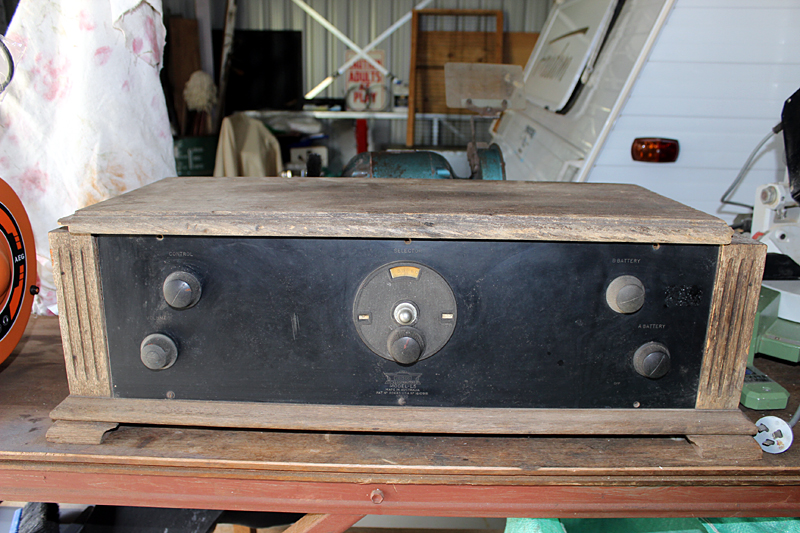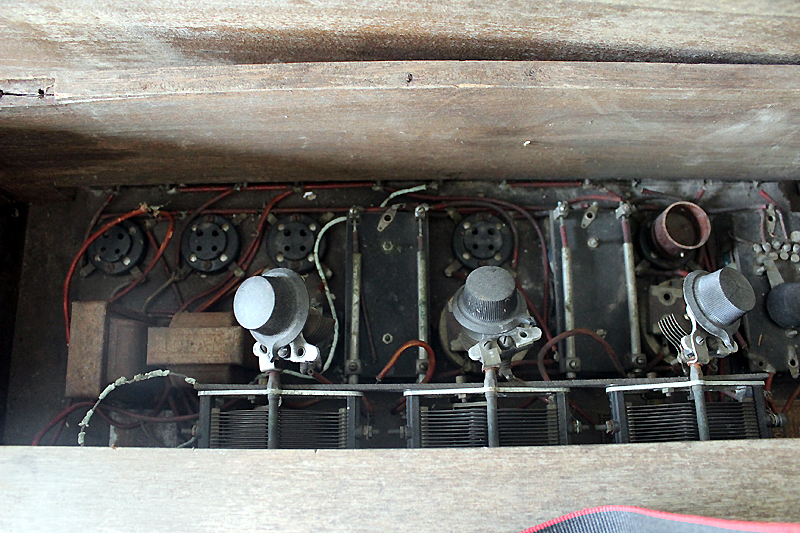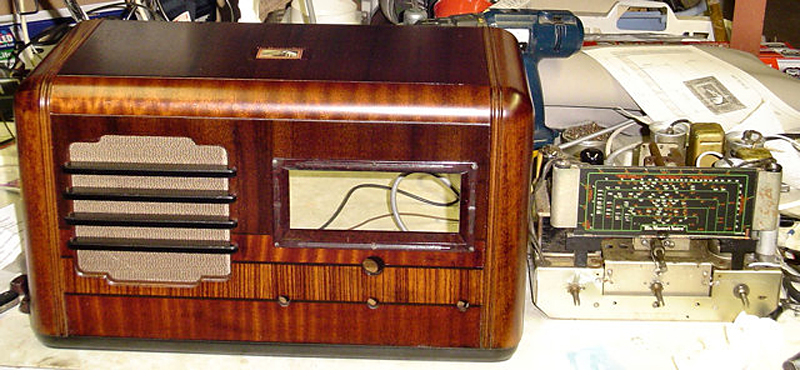Cabinet Repairs
Forum home - Go back to Cabinet Repairs
|
1927 UDISCO radio cabinet restoration
|
|
|
« Back ·
1 ·
Next »
|
|
|
Return to top of page · Post #: 1 · Written at 5:05:35 PM on 7 January 2017.
|
|
|
|
Location: Hobart, TAS
Member since 6 May 2013 Member #: 1337 Postcount: 73 |
|
I recently acquired a UDISCO model L-5 battery powered five valve TRF radio from 1927. Due to the age of this radio I would like to restore the cabinet on this radio using the original methods. I'm looking for advice or information on restoring the original finish for this radio. Normally for radios of this age I prefer to preserve the original finish but as you can see from the photos the original finish has gone after years of neglect. If anyone has restored a UDISCO radio I would like to know if the original finish was nitrocellulose laquer, shellac or beeswax.   |
|
|
Return to top of page · Post #: 2 · Written at 8:35:52 PM on 8 January 2017.
|
|
|
|
Location: Western Victoria, VIC
Member since 14 November 2009 Member #: 579 Postcount: 110 |
|
Hi Sam, ‾‾‾‾‾‾‾‾‾‾‾‾‾‾‾‾‾‾‾‾‾‾‾‾‾‾‾‾‾‾‾‾‾‾‾‾‾‾‾‾‾‾‾‾‾‾‾‾‾‾‾‾‾‾‾‾‾‾‾‾‾‾‾‾‾‾‾‾ Robert |
|
|
Return to top of page · Post #: 3 · Written at 8:56:23 PM on 8 January 2017.
|
|
|
|
Administrator
Location: Naremburn, NSW
Member since 15 November 2005 Member #: 1 Postcount: 7577 |
|
I have a similar Udisco, much the same radio with a slightly different front panel layout. I am fairly sure it is finished with nitro. The finish is shiny so it is not beeswax, which has a more subdued finish. ‾‾‾‾‾‾‾‾‾‾‾‾‾‾‾‾‾‾‾‾‾‾‾‾‾‾‾‾‾‾‾‾‾‾‾‾‾‾‾‾‾‾‾‾‾‾‾‾‾‾‾‾‾‾‾‾‾‾‾‾‾‾‾‾‾‾‾‾ A valve a day keeps the transistor away... |
|
|
Return to top of page · Post #: 4 · Written at 6:26:18 PM on 9 January 2017.
|
|
|
|
Location: Hobart, TAS
Member since 6 May 2013 Member #: 1337 Postcount: 73 |
|
Thanks for your help Robert and Brad. The serial number on this set is 890. I am in the process of cleaning and tracing the circuit for this set. May I kindly ask the valve line up and the battery voltages for your set Robert? The valves are missing from my set. I did find the Bakelite base of a B605 but the glass bulb had been broken. I can then look at obtaining valves and building a suitable power supply. |
|
|
Return to top of page · Post #: 5 · Written at 9:14:24 PM on 9 January 2017.
|
|
|
|
Location: Tamworth, NSW
Member since 6 April 2012 Member #: 1126 Postcount: 472 |
|
Nitro is still available. You may need to go to a specialist paint supplier. You are looking for Wattyl Stylwood. There are a few different gloss levels available (10, 30, 50, 70 and 95%). 70% looks the part. |
|
|
Return to top of page · Post #: 6 · Written at 9:15:51 PM on 9 January 2017.
|
|
|
|
Administrator
Location: Naremburn, NSW
Member since 15 November 2005 Member #: 1 Postcount: 7577 |
|
I agree, not to use something that is too shiny. 70% is the go. ‾‾‾‾‾‾‾‾‾‾‾‾‾‾‾‾‾‾‾‾‾‾‾‾‾‾‾‾‾‾‾‾‾‾‾‾‾‾‾‾‾‾‾‾‾‾‾‾‾‾‾‾‾‾‾‾‾‾‾‾‾‾‾‾‾‾‾‾ A valve a day keeps the transistor away... |
|
|
Return to top of page · Post #: 7 · Written at 9:22:16 PM on 10 January 2017.
|
|
|
|
Location: Western Victoria, VIC
Member since 14 November 2009 Member #: 579 Postcount: 110 |
|
Hi Sam, ‾‾‾‾‾‾‾‾‾‾‾‾‾‾‾‾‾‾‾‾‾‾‾‾‾‾‾‾‾‾‾‾‾‾‾‾‾‾‾‾‾‾‾‾‾‾‾‾‾‾‾‾‾‾‾‾‾‾‾‾‾‾‾‾‾‾‾‾ Robert |
|
|
Return to top of page · Post #: 8 · Written at 9:31:22 PM on 10 January 2017.
|
|
|
|
Location: Western Victoria, VIC
Member since 14 November 2009 Member #: 579 Postcount: 110 |
|
I forgot to add that the voltages are the common 20's hook up - 120 volt HT to OP valve via the horn, a tap at 90 volts fed to the first audio anode, and 22 volts to the detector anode. The A voltage according to the valve type (B605 = 6V, B405 = 5V). A- usually connected to B-, but not always! And lastly, a C bias supply which is usually around 4.5 volts. Usually connected positive side to A- and B- and the negative to the grids of the audio valves - often directly to the 'grid' connection of the audio transformer - but you should be able to trace this from the actual connection / terminal posts of the set. Hope this all makes sense. ‾‾‾‾‾‾‾‾‾‾‾‾‾‾‾‾‾‾‾‾‾‾‾‾‾‾‾‾‾‾‾‾‾‾‾‾‾‾‾‾‾‾‾‾‾‾‾‾‾‾‾‾‾‾‾‾‾‾‾‾‾‾‾‾‾‾‾‾ Robert |
|
|
Return to top of page · Post #: 9 · Written at 9:42:48 AM on 11 January 2017.
|
|
|
|
Location: Wangaratta, VIC
Member since 21 February 2009 Member #: 438 Postcount: 5646 |
|
I rarely do anything with cabinets I had a customer that wanted a total refurbish of his Table HMV (it has been posted, albeit I will have photos).  There is an antique restorer In Mackay St, Wangaratta that was still using Nitrocellulose at the time, but it is I believe being phased out like anything else that works. This cabinet looked probably better than it did new, after he got through with it. Nitrocellulose has the problem of self destructing, but the big thing with it is that each layer actually melts into the previous one and it levels really well. Solvents such as Methylated Spirits (Principally Ethanol) will severely damage it. Those valves are in the Philips book but I would believe also on Franks Electron Tube Pages. The plot is similar in all of them, some filament valves do have polarity on the filaments as they are part of their bias, the Grid leak is often different (& resistor failed most times) positive side of filament (UX201A RCA data) Marc |
|
|
Return to top of page · Post #: 10 · Written at 10:03:45 PM on 12 January 2017.
|
|
|
|
Location: Hobart, TAS
Member since 6 May 2013 Member #: 1337 Postcount: 73 |
|
Hi Robert, The audio transformers are DEAL transformers made by AWA. My 1930 AWA Radiola forty five contains very similar DEAL audio transformers. I have checked the continuity of the windings. The first transformer is good but the second audio transformer appears to have an open circuit on the secondary winding. I will check to see if the break is near the start of the winding and repairable. Thankyou for your help with the valve lineup and voltages. This is my first battery TRF set. Most of the information I find on battery voltages for 1920's TRF sets usually deal with American sets with RCA valves. |
|
|
Return to top of page · Post #: 11 · Written at 10:47:51 PM on 12 January 2017.
|
|
|
|
Location: Wangaratta, VIC
Member since 21 February 2009 Member #: 438 Postcount: 5646 |
|
Mother used to work in a picture theatre in those days and a cousin was a projectionist. Some funny stories. They had a fireman, but there was no 000 you rang the RSL. |
|
|
« Back ·
1 ·
Next »
|
|
|
You need to be a member to post comments on this forum.
|
|

Sign In

Vintage Radio and Television is proudly brought to you by an era where things were built with pride and made to last.
DISCLAIMER: Valve radios and televisions contain voltages that can deliver lethal shocks. You should not attempt to work on a valve radio or other electrical appliances unless you know exactly what you are doing and have gained some experience with electronics and working around high voltages. The owner, administrators and staff of Vintage Radio & Television will accept no liability for any damage, injury or loss of life that comes as a result of your use or mis-use of information on this website. Please read our Safety Warning before using this website.
WARNING: Under no circumstances should you ever apply power to a vintage radio, television or other electrical appliance you have acquired without first having it checked and serviced by an experienced person. Also, at no time should any appliance be connected to an electricity supply if the power cord is damaged. If in doubt, do not apply power.
Shintara - Keepin' It Real · VileSilencer - Maintain The Rage
